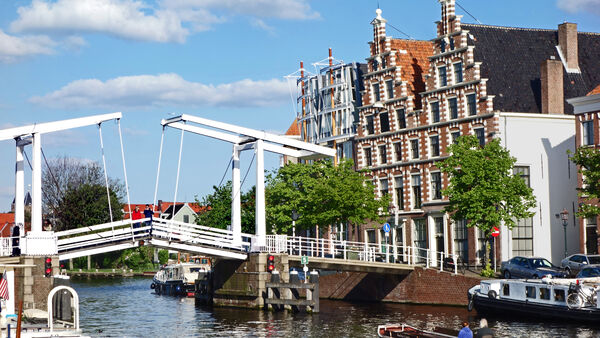Highlights of Haarlem
By Rick Steves
A Golden Age kind of town, friendly Haarlem is quintessentially Dutch, offering small-town warmth and quick access to nearby Amsterdam.
Bustling Haarlem gave America's Harlem its name back when New York was "New Amsterdam," a Dutch colony. For centuries, Haarlem has been a market town, buzzing with shoppers heading home with fresh bouquets.
Enjoy the market on Monday (clothing) or Saturday (general), when the square bustles like a Brueghel painting with cheese, fish, flowers, and families. Make yourself at home — buy some flowers to brighten your hotel room.
Grote Markt (Market Square), where 10 streets converge, is the town's delightful centerpiece...as it has been for 700 years. To enjoy a coffee or beer here, simmering in Dutch good living, is a quintessential European experience. Observe. Sit and gaze at the church, appreciating essentially the same scene that Dutch artists captured centuries ago in oil paintings that now hang in museums.
Until the 1990s, trolleys ran through the square and cars were parked everywhere. But now it's a people zone, with market stalls filling the square on market days and café tables on other days. This is a great place to build a picnic with Haarlem finger foods: raw herring, local cheese (Gouda and Edam), a frikandel (little corn-dog sausage), French fries with mayonnaise, stroopwafels (waffles with syrup), poffertjes (little sugar doughnuts), or one of many different international foods (falafel, shoarma, Indonesian).
Overseeing the square is a statue of L. J. Coster (c. 1370–1440), the man Haarlemmers credit with creating modern printing techniques. Forty years before Gutenberg "invented" the first printing press, this man carved the letter "A" out of wood, dropped it into some wet sand and saw the imprint it left. He got the idea of making movable type out of wood (and later he may have tried using lead). In the statue, Coster holds up a block of movable type and points to himself, saying: "I made this." How much Coster did is uncertain, but Gutenberg trumped him by building a printing press, casting type in metal, and pounding out the Bible. (And the Chinese beat them both by several centuries.)
Also on Haarlem's market square is the Town Hall, the site of the city's government since about 1100 (when William the Conqueror ruled England). While most of medieval Europe was ruled by kings, dukes, and barons, Haarlem has been largely self-governing since 1425.
The town drunk used to hang out on the bench in front of the Town Hall, where he'd expose himself to newlyweds coming down the stairs. The Dutch, rather than arrest the man, simply moved the bench. No bench, no problem.
Rising above the square is the impressive Grote Kerk (Great Church), one of the most famous landmarks in the Netherlands. Sit and gaze at the church, appreciating the same scene that Golden Age Dutch artists captured in oil paintings you'll see in Dutch museums.
The interior of the 16th-century church is dominated by Holland's greatest pipe organ. It's 100 feet high, with 5,000 pipes and a sound that impressed both Handel and Mozart. During the summer months, the church hosts free concerts.
Another of Haarlem's gems is the Frans Hals Museum, a tribute to the hometown artist who became the foremost Dutch portrait painter of the 17th-century Golden Age. This bold humanist painted everyday people in their warts-and-all glory. He was a forerunner of Impressionist brushwork, a master of composition, and an articulate visual spokesman for his generation. And this refreshing museum — located in a 17th-century almshouse — displays many of the masterful portrait painter's greatest works.
Across the street, the small Haarlem Museum offers a glimpse of old Haarlem. During the city's Golden Age four centuries ago, Haarlem was a thriving commercial center rivaling Amsterdam. Back then, the town was a port on the large Haarlemmer Lake, with the North Sea only about five miles away (threatened by floods, residents eventually diverted the lake into canals to preserve shipping business, and then pumped the remaining land dry). As well as being Holland's tulip capital, Haarlem was a manufacturing center producing wool, silk, lace, damask cloth, furniture, smoking pipes (along with cheap, locally grown tobacco), and mass quantities of beer. Haarlemmers were notorious consumers of beer. It was a popular breakfast drink, and the average person drank six pints a day.
For a somber look at Haarlem history, visit the Corrie ten Boom House, where the Ten Boom family created a safe haven for Jews during World War II. This museum gives the other half of the Anne Frank story: the point of view of those who risked their lives to hide Dutch Jews during the Nazi occupation. Living above the family clock shop, Corrie and her sister Betsy, both in their 50s, and their elderly father built a secret room in the very back of their home off Corrie's tiny bedroom. They used the small hideaway to house six to seven Jews at a time.
In 1944, the Gestapo — tipped off that the family was harboring Jews — burst into the Ten Boom house. Finding a suspiciously high number of ration coupons, the Nazis arrested the family (but failed to find the six Jews in the hiding place, who later escaped). Corrie's father and sister died while in prison, but Corrie survived the Ravensbrück concentration camp to tell her story in inspirational 1971 book (and 1975 movie), The Hiding Place.
To sample more of Haarlem, take a scenic cruise through the canals, or wander through the city's little red light district two blocks off Grote Markt. Legal since the 1980s, it's a warm-up for the more brazen and boisterous experience that awaits in Amsterdam, just a short ride away by train.


